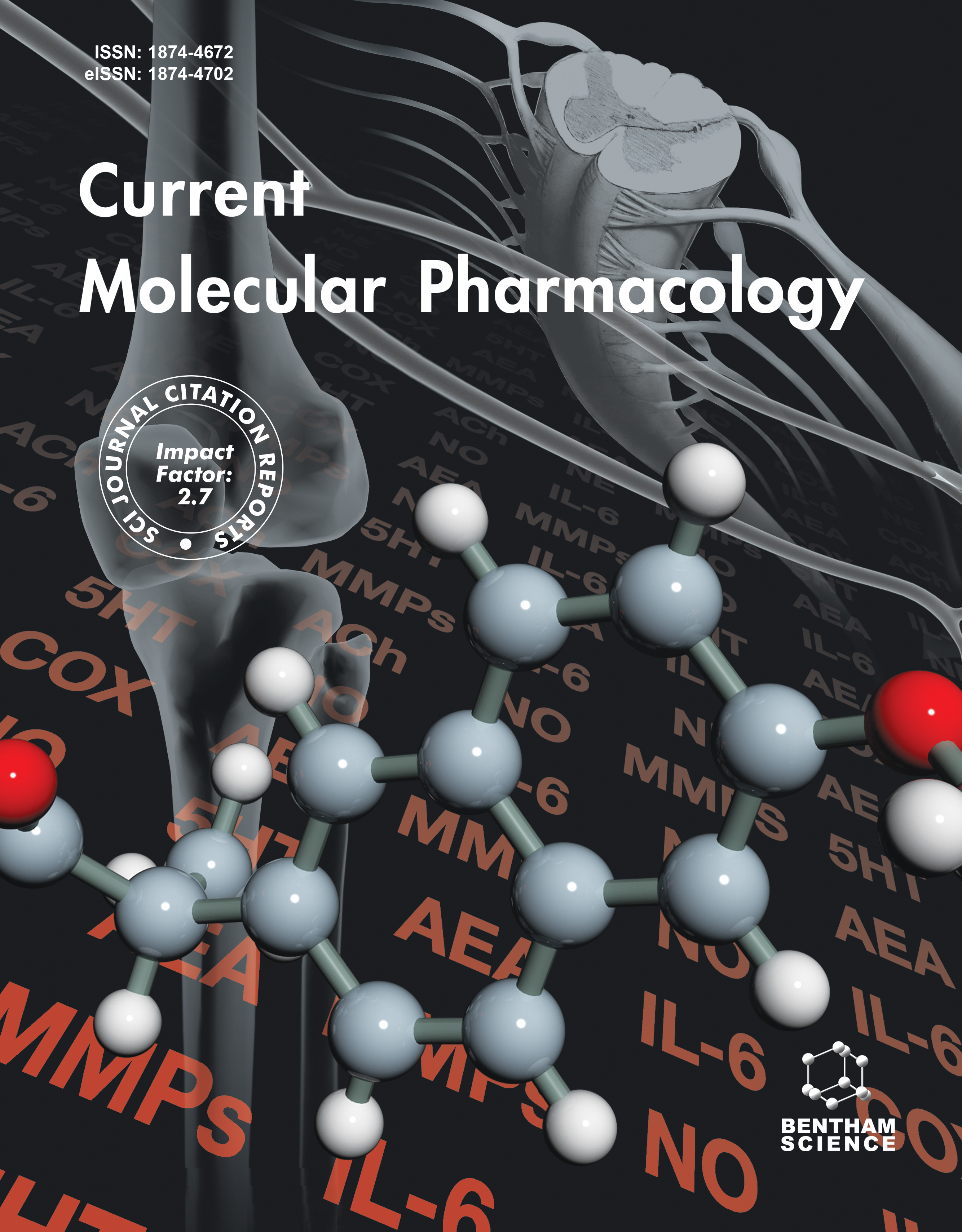- Home
- A-Z Publications
- Current Molecular Pharmacology
- Previous Issues
- Volume 17, Issue 1, 2024
Current Molecular Pharmacology - Volume 17, Issue 1, 2024
Volume 17, Issue 1, 2024
-
-
Antimicrobial Resistance of Clinical Klebsiella pneumoniae Isolates: Involvement of AcrAB and OqxAB Efflux Pumps
More LessAuthors: Osman Albarri, Manaf AlMatar, Işil Var and Fatih KöksalBackgroundOver the last several decades, the AcrAB and OqxAB efflux pumps have been found to cause multidrug resistance (MDR) in various bacteria, most notably Klebsiella pneumoniae. Antibiotic resistance surges with increased expression of the acrAB and oqxAB efflux pumps.MethodsIn accordance with CLSI guidelines, a disk diffusion test was carried out using 50 K. pneumoniae isolates obtained from v Read More
-
-
-
DDR1-Induced Paracrine Factors of Hepatocytes Promote HSC Activation and Fibrosis Development
More LessAuthors: Ying Meng, Tong Zhao, Tiyun Han, Huilin Chen, Zhengyi Zhang and Dekui ZhangBackgroundThis study investigated the role and potential mechanisms of Discoidin domain receptors-1 (DDR1) during liver fibrogenesis.MethodsBlood and livers were collected from mice. In the in vitro experiments, human normal hepatocyte (LO2 cell line) and human hepatoma cells (HepG2 cell line) with overexpressed DDR1 (DDR1-OE) or DDR1 knockdown (DDR1-KD) were constructed by transfecting Read More
-
-
-
A Detailed Review of Molecular Pathways and Mechanisms Responsible for the Development and Aggravation of Neuropathy and Nephropathy in Diabetes
More LessAuthors: Phool Chandra, Neetu Sachan, Nikita Saraswat and Niraj VyawahareBackgroundDiabetic mellitus is responsible for triggering many conditions, such as neuropathy, nephropathy, and retinopathy. Hyperglycemia leads to the development of oxidative stress conditions, activation of pathways, and generation of metabolites, leading to complications like neuropathy and nephropathy.ObjectiveThis paper aims to discuss the mechanism of actions, pathways, and metabolites triggered due to the develo Read More
-
-
-
Protective Effect of Chrysin against Chlorpyrifos-Induced Metabolic Impairment and Pancreatitis in Male Rats
More LessBackgroundThis study was performed to evaluate the protective effects of chrysin (CH) on metabolic impairment and pancreatic injury caused by sub-chronic chlorpyrifos (CPF) intoxication in male rats.MethodsForty male Wistar rats were randomly allocated into five groups (n=8). Intraperitoneal injections of chrysin (12.5, 25 and 50 mg/kg for 45 days) and CPF (10 mg/kg for 45 days) gavage were performed. Prese Read More
-
-
-
A Comprehensive Review of Essential Aspects of Molecular Pathophysiological Mechanisms with Emerging Interventions for Sarcopenia in Older People
More LessBackground:As people age, physical impairments may have a deleterious role on skeletal muscles. Sarcopenia Clinical Practice Guidelines 2017 and the European Working Group on Sarcopenia in older people are two organizations that have published essential guidelines on the definition of “Sarcopenia”. Sarcopenia is a geriatric syndrome, characterized by skeletal muscle mass degeneration brought on by ageing, which low Read More
-
-
-
Fenbufen Alleviates Severe Acute Pancreatitis by Suppressing Caspase-1/Caspase-11-mediated Pyroptosis in Mice
More LessAuthors: Shien Shen, Wenqin Xiao, Weiliang Jiang, Kai Li, Xingya Guo, Guanzhao Zong, Chuanyang Wang, Jingpiao Bao, Jiahui Chen, Zhiyuan Cheng, Jie Shen and Rong WanAimIn the present study, we aimed to investigate the effects of Fenbufen treatment on the SAP model induced by caerulein and lipopolysaccharide.BackgroundSevere acute pancreatitis (SAP) is an extremely dangerous disease with high mortality, which is associated with inflammatory response and acinar cell death. The caspase family plays an important role in cell death, such as caspase-1 and caspase-1 Read More
-
-
-
Targeting Cellular Senescence: A Potential Therapeutic approach for Alzheimer’s Disease
More LessAuthors: Shrishti Singh and Lokesh Kumar BhattAlthough Amyloid beta plaque and neurofibrillary tangles are considered the two main hallmarks of Alzheimer’s disease (AD), the mechanism by which they contribute is not clearly understood. Cellular senescence (CS) has been demonstrated to be a key characteristic of AD. Recent research suggests that persistent buildup of senescent cells over time results in protracted activation of inflammatory stress as an organism ages Read More
-
-
-
A Network Medical Framework based on Inflammatory Genes to Identify Drug Candidates for Abdominal Aortic Aneurysms
More LessAuthors: Xiaoyang Niu and Bing WangBackgroundClinically, abdominal aortic aneurysms (AAA) can be treated with surgical intervention, but there is currently no effective drug for the disease.MethodsThis study analyzed the biomedical data of single-cell RNA sequencing (scRNA-seq), RNA-seq and the network medical data of drug-target interaction as well as protein-protein interaction to identify key targets and potential drug compounds of AAA.ResultsFirstly, Read More
-
-
-
Progress of Angiogenesis Signal Pathway and Antiangiogenic Drugs in Nasopharyngeal Carcinoma
More LessAuthors: Yunzhi Zhu, Yi Hu, Chengsheng Yang, Shipu Huang, Jianping Wen, Weiguo Huang and Shengjun XiaoNasopharyngeal cancer is a rare cancer with unique ethnic and geographic distribution. Since nasopharyngeal cancer often originates from the pharyngeal crypt, early symptoms are not obvious. They are difficult to detect in time, and the disease is usually diagnosed and treated only when it has progressed to an advanced-stage. Since angiogenesis is essential for the growth and invasion of solid tumors, antiangiogenic therap Read More
-
Volumes & issues
Most Read This Month
Article
content/journals/cmp
Journal
10
5
false
en


